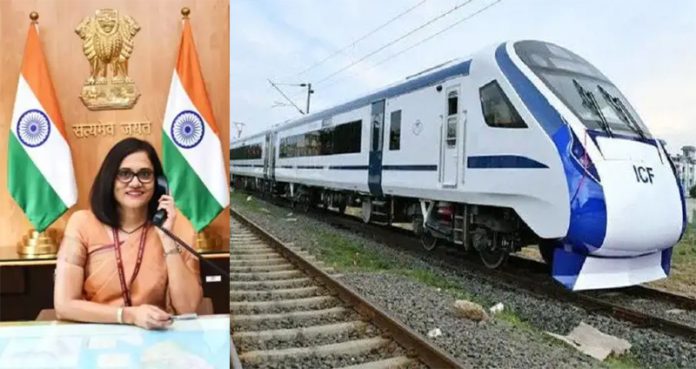NEW DELHI, May 14 : Railway Board Chairperson and CEO Jaya Verma Sinha along with senior railway officials of North Central and Northern Railways inspected a Kavach trial on Tuesday in Vande Bharat train between Palwal and Vridavan.
Sinha, while travelling in the eight-car set Vande Bharat, which ran at 160 kmph speed, had a first hand experience of Kavach working system at red signals, loop lines and other speed restriction points.
“The trial, conducted under the overall supervision of Kush Gupta, Deputy Chief Signal and Telecommunication Engineer, was successful as the train stopped at red signals on its own with the help of Kavach,” a senior official of the Railways said.
The official added, “The train followed all speed restrictions with the help of Kavach without the loco pilot’s interference. For instance, it was supposed to slow down to 30 kmph to enter the loop line near Chhata, one of the stations on the Palwal-Vridavan route, which it did in quite a precise manner.”
Officials who participated in the trial said that Sinha was highly impressed with the successful functioning of Kavach which followed all parameters efficiently.
Sinha boarded the Vande Bharat at 9:15 am from Palwal station along with other senior railway officials such as General Manager, North Central Railways and General Manager, Northern Railways, Principal Chief Signal and Telecom Engineer, NCR Zone; Principal Executive Director, Railway Board and Divisional Railway Manager, Agra.
“The train reached Sholaka station at 9:38 am and it was supposed to stop at a red signal before entering the next station, Hodal. Running at 160 kmph, the Kavach system read the red signal and applied the brakes automatically from around 1,300-meter distance,” a railway official said.
“It stopped just 9 meters before the signal and everyone, including the Chairperson, expressed satisfaction,” he added.
According to railway officials, the train followed all permanent speed restrictions and slowed down where it was required on its own with the help of Kavach system and without any manual interference of the loco pilot.
“The train reached Vrindavan at 10:45 am. The Chairperson also inspected the Kavach system fitted at Vrindavan station, ” Srivastava said. The return journey started from Vrindavan at 11:10 am and reached Palwal by 12:30 pm.
All Vande Bharat trains are fitted with a ‘Kavach’ system, which can apply brakes on its own in case the loco pilot fails to do it due to any reason.
Before the inspection by the Chairperson, the Agra division, under the supervision of Gupta, successfully conducted three Kavach trials at 140 kmph and 160 kmph for other mail, express as well as Vande Bharat trains.
The Agra division has developed a complete Kavach network on the 80-km stretch between Mathura (excluding the station) and Palwal. This involves the placement of RFID tags on railway tracks in station areas and other places, installation of stationary Kavach units at several places such as stations, and installation of towers and antennas along the tracks.
The Kavach system, developed by the Research Designs and Standards Organisation (RDSO), can apply brakes automatically in case of an emergency when a train driver fails to act in time.
According to RDSO officials, a 125-km stretch in three parts between Delhi and Agra is the only stretch across the entire rail network where trains can run at a maximum speed of 160 kmph. Trains run at a maximum speed of 130 kmph on all other sections in India.
The special track was laid here for India’s first semi-high speed train Gatimaan Express, which was launched in April 2016. (PTI)


